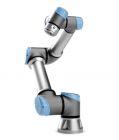


"UR Building a Case for Automation" is a whitepaper published by Universal Robotics. The document aims to provide insights and guidance on the benefits and implementation of automation using Universal Robots (UR) technology.
This synopsis will summarize the key points addressed in the whitepaper, outlining the advantages of automation, the challenges faced by industries, and the role of UR robots in revolutionizing manufacturing processes. To read the entire whitepaper, please click the button to the right. For a brief synopsis, please read on.
The Need for Automation
The whitepaper begins by emphasizing the increasing need for automation in various industries. It highlights how automation can help address the challenges faced by companies, such as labor shortages, rising production costs, and the demand for improved productivity and efficiency. The authors argue that automation offers a viable solution to these issues, allowing businesses to streamline their operations, reduce human error, and achieve higher output levels.
The Benefits of UR Robotics
The next section of the whitepaper focuses on the advantages of using Universal Robots in automation applications. It highlights the flexibility, ease of programming, and collaborative nature of UR robots, making them suitable for a wide range of tasks and environments. The document emphasizes the safety features incorporated into UR robots, enabling them to work alongside human operators without compromising on workplace safety. Additionally, the whitepaper highlights the cost-effectiveness and quick return on investment (ROI) associated with implementing UR robots.
Successful Case Studies
The whitepaper presents several real-world case studies that showcase the successful implementation of UR robots across different industries. It provides examples of how UR robots have revolutionized manufacturing processes, including pick and place operations, assembly tasks, and quality control. The case studies illustrate the significant improvements achieved in terms of production speed, accuracy, and overall operational efficiency. By demonstrating these successful applications, the whitepaper aims to inspire and educate readers about the potential benefits of UR robot integration.
Overcoming Challenges and Implementation Considerations
Recognizing that implementing automation can present challenges, the whitepaper offers valuable insights into overcoming common obstacles. It addresses concerns such as integrating robots into existing workflows, providing suitable training to employees, and ensuring a smooth transition from manual to automated processes. The authors emphasize the importance of strategic planning, thorough analysis of production requirements, and close collaboration with experts to ensure a successful automation implementation.
Looking Towards the Future
The final section of the whitepaper looks ahead to the future of automation, emphasizing the potential for continued advancements in robotics and artificial intelligence. It discusses emerging technologies, such as machine learning and the Internet of Things (IoT), and their potential impact on automation. The authors predict that as automation becomes more widespread, industries will experience increased productivity, reduced costs, and improved product quality, ultimately leading to new business opportunities and growth.










